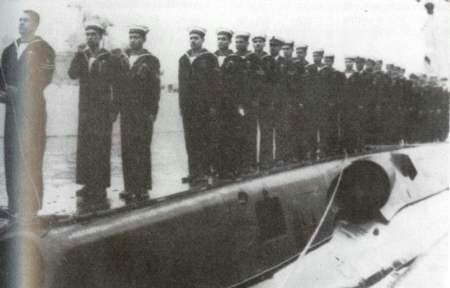Windjammer
ELITE MEMBER

- Joined
- Nov 9, 2009
- Messages
- 41,290
- Reaction score
- 181
- Country
- Location
“The Story of the Pakistan Navy” has recounted the events as seen from the submarine HANGAR which sank the KHUKRI.
HANGAR had sailed from Karachi on 22 November for a patrol off the Saurashtra coast. On 1 December, she was ordered to shift to the area off Bombay to relieve her sister submarine MANGRO who was completing her patrol.
On 2 December, HANGAR sighted the Western Fleet which was on its way to its patrol area. HANGAR reported this to Karachi and continued her patrol off Bombay. She was unable to find good warship targets. Thereafter “The Story of the Pakistan Navy” states
“In an effort to locate the evasive enemy, HANGAR extended her patrol northwards to investigate some radio transmissions that she had intercepted on her sensors. In the early hours of the morning of 9 December, when she was off the Kathiawar coast, two contacts were picked up on her passive sonar on a northeasterly bearing. They were easily identified as warships by their sonar transmissions; radar indicated a range of 6 to 8 miles. A pursuit of the enemy began.
“When the first attempt to intercept the ships failed, the submarine began snorkelling to gain speed. HANGAR however, failed to attract the attention of the ships and contact was lost as the range increased. By the evening of 9 December, she was able to make out the pattern of their movement by tracking them with the aid of her sensors. The ships were carrying out a rectangular anti-submarine search.
“Forecasting their movement along this search pattern, the submarine succeeded by 1900 in taking up a tactically advantageous position on the path of the patrolling frigates. The range of the ships, which were moving at a speed of 12 knots, began to close. The crucial moment which the submarine had patiently worked for since the early hours of the morning had arrived. HANGAR was finally in a position to launch an attack.
“At 1915 she went to action stations. Fifteen minutes later she came up to periscope depth but could see nothing in the dark night when the range of the ships indicated by her periscope radar was only 9800 meters. The ships were completely darkened. The Commanding Officer decided to go down to 55 metres depth and make a sonar approach for the final phase of the attack. Unaware of the submarine’s presence the frigates continued on their track. At 1957 HANGAR fired a down-the-throat shot with a homing torpedo at the northerly ship from a depth of 40 metres. The torpedo was tracked but no explosion was heard. This was not the time to brood over the situation. The control team sprang into action and fired a second torpedo. After five tense minutes a tremendous explosion was heard at 2019 hours. The torpedo had found its mark. The other enemy frigate came straight for the submarine. HANGAR fired a third torpedo and turned away at maximum speed. A distant explosion was heard subsequently.
“Moving west towards deeper waters where she would be less vulnerable the submarine passed very close to the scene of action and heard distinctly the noise of explosions emanating from the burning wreck. Later she came up to periscope depth and took a last look. In the dark nothing could be seen except a faint glow on the horizon near the scene of action.
“In an extremely vulnerable position in enemy controlled shallow waters where no help could reach her the task that lay ahead of HANGAR was to evade her pursuers in the hunt that followed-the first signs of which came when a number of underwater explosions were heard just about half an hour after the attack. For the next four days. HANGAR braved the might of the Western Fleet. All their anti-submarine assets frigates Seaking helicopters and Alize aircraft were thrown into the chase that followed .. A hunter killer (anti-submarine) operation fully supported by IAF reconnaissance aircraft based ashore in the area was put into effect.
“The first priority of HANGAR after the attack was to get into deeper waters and put as much distance between her and the position from which the torpedoes were fired the datum (reference point) for the search by enemy units. Having successfully done that she began her journey back home. For four days and nights she was harassed by the enemy. The dimensions of the enemy anti-submarine effort can be gauged from the fact that about 150 underwater projectiles were fired in this period. Only on one occasion were the explosions close enough to shake the submarine.
“The Commanding Officer was naturally keen to pass the information of this successful attack to Naval Headquarters. The submarine had to come up as it cannot transmit radio messages while submerged. She took the risk of being fixed by enemy direction finding stations ashore while transmitting the message. Enemy aircraft were overhead soon after the message was sent. Intense air activity throughout the day forced the submarine to run silent and run deep reducing her speed of advance to 1.5 knots.
“There were of course many close calls during the passage back to Karachi. The Indian Navy called off the futile hunt on the evening of 13 December. There were claims by some of their units to have sunk the submarine but she arrived unharmed at Karachi on 18 December.
“In this spectacular action which took place about 30 miles south of Diu off the Indian Kathiawar coast. KHUKRI the ship of the Squadron Commander of the 14th Frigate Squadron was sunk within two minutes after receiving a hit in the magazine where explosives were stowed. 18 officers and 176 sailors including the Commanding Officer who deliberately stayed back on the sinking ship lost their lives.
This came as a shattering blow to the Indian Navy deflating in one stroke the exuberance generated by highly exaggerated success stories of the missile attacks at ships off Karachi.
HANGAR had sailed from Karachi on 22 November for a patrol off the Saurashtra coast. On 1 December, she was ordered to shift to the area off Bombay to relieve her sister submarine MANGRO who was completing her patrol.
On 2 December, HANGAR sighted the Western Fleet which was on its way to its patrol area. HANGAR reported this to Karachi and continued her patrol off Bombay. She was unable to find good warship targets. Thereafter “The Story of the Pakistan Navy” states
“In an effort to locate the evasive enemy, HANGAR extended her patrol northwards to investigate some radio transmissions that she had intercepted on her sensors. In the early hours of the morning of 9 December, when she was off the Kathiawar coast, two contacts were picked up on her passive sonar on a northeasterly bearing. They were easily identified as warships by their sonar transmissions; radar indicated a range of 6 to 8 miles. A pursuit of the enemy began.
“When the first attempt to intercept the ships failed, the submarine began snorkelling to gain speed. HANGAR however, failed to attract the attention of the ships and contact was lost as the range increased. By the evening of 9 December, she was able to make out the pattern of their movement by tracking them with the aid of her sensors. The ships were carrying out a rectangular anti-submarine search.
“Forecasting their movement along this search pattern, the submarine succeeded by 1900 in taking up a tactically advantageous position on the path of the patrolling frigates. The range of the ships, which were moving at a speed of 12 knots, began to close. The crucial moment which the submarine had patiently worked for since the early hours of the morning had arrived. HANGAR was finally in a position to launch an attack.
“At 1915 she went to action stations. Fifteen minutes later she came up to periscope depth but could see nothing in the dark night when the range of the ships indicated by her periscope radar was only 9800 meters. The ships were completely darkened. The Commanding Officer decided to go down to 55 metres depth and make a sonar approach for the final phase of the attack. Unaware of the submarine’s presence the frigates continued on their track. At 1957 HANGAR fired a down-the-throat shot with a homing torpedo at the northerly ship from a depth of 40 metres. The torpedo was tracked but no explosion was heard. This was not the time to brood over the situation. The control team sprang into action and fired a second torpedo. After five tense minutes a tremendous explosion was heard at 2019 hours. The torpedo had found its mark. The other enemy frigate came straight for the submarine. HANGAR fired a third torpedo and turned away at maximum speed. A distant explosion was heard subsequently.
“Moving west towards deeper waters where she would be less vulnerable the submarine passed very close to the scene of action and heard distinctly the noise of explosions emanating from the burning wreck. Later she came up to periscope depth and took a last look. In the dark nothing could be seen except a faint glow on the horizon near the scene of action.
“In an extremely vulnerable position in enemy controlled shallow waters where no help could reach her the task that lay ahead of HANGAR was to evade her pursuers in the hunt that followed-the first signs of which came when a number of underwater explosions were heard just about half an hour after the attack. For the next four days. HANGAR braved the might of the Western Fleet. All their anti-submarine assets frigates Seaking helicopters and Alize aircraft were thrown into the chase that followed .. A hunter killer (anti-submarine) operation fully supported by IAF reconnaissance aircraft based ashore in the area was put into effect.
“The first priority of HANGAR after the attack was to get into deeper waters and put as much distance between her and the position from which the torpedoes were fired the datum (reference point) for the search by enemy units. Having successfully done that she began her journey back home. For four days and nights she was harassed by the enemy. The dimensions of the enemy anti-submarine effort can be gauged from the fact that about 150 underwater projectiles were fired in this period. Only on one occasion were the explosions close enough to shake the submarine.
“The Commanding Officer was naturally keen to pass the information of this successful attack to Naval Headquarters. The submarine had to come up as it cannot transmit radio messages while submerged. She took the risk of being fixed by enemy direction finding stations ashore while transmitting the message. Enemy aircraft were overhead soon after the message was sent. Intense air activity throughout the day forced the submarine to run silent and run deep reducing her speed of advance to 1.5 knots.
“There were of course many close calls during the passage back to Karachi. The Indian Navy called off the futile hunt on the evening of 13 December. There were claims by some of their units to have sunk the submarine but she arrived unharmed at Karachi on 18 December.
“In this spectacular action which took place about 30 miles south of Diu off the Indian Kathiawar coast. KHUKRI the ship of the Squadron Commander of the 14th Frigate Squadron was sunk within two minutes after receiving a hit in the magazine where explosives were stowed. 18 officers and 176 sailors including the Commanding Officer who deliberately stayed back on the sinking ship lost their lives.
This came as a shattering blow to the Indian Navy deflating in one stroke the exuberance generated by highly exaggerated success stories of the missile attacks at ships off Karachi.












